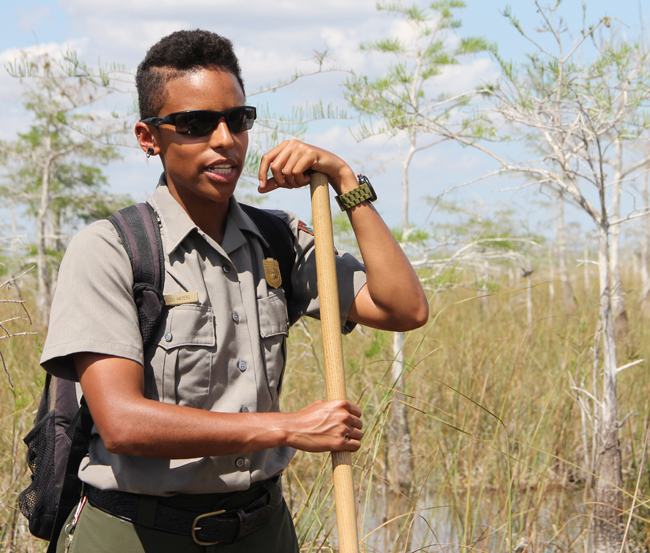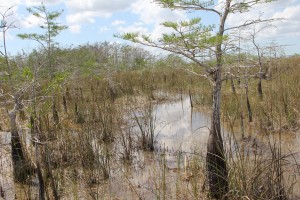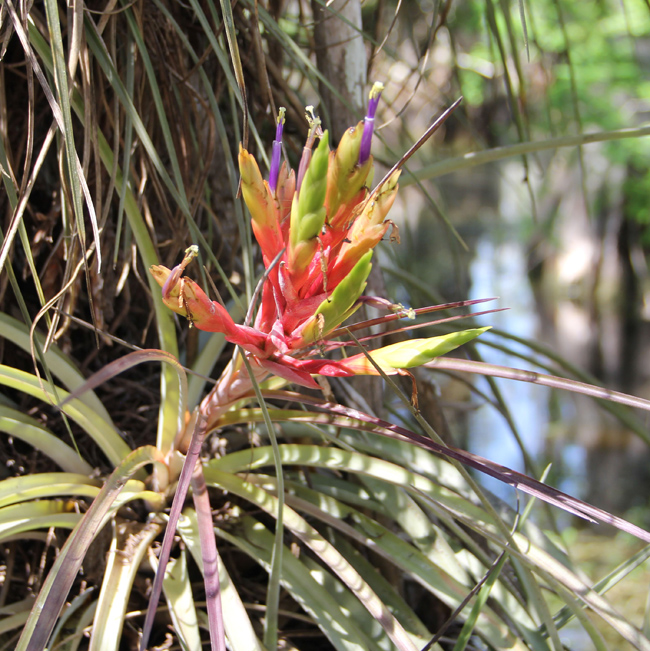Hikers Find ‘Day Of Creation’
By Domenica Ghanem
Immediately, the crowd was skeptical.
Bleu Waters, a ranger at Everglades National Park and the guide for this walk, handed out walking sticks. “These are for fighting off the alligators,” she said, stone faced. “If you see one, hold its head down with this and yell for me to come over.”
Everyone exchanged surprised, nervous glances, not sure if she was being serious.
“My socks are going to get so wet,” one tourist complained.
As each person took that first step into the mud of the slough slog they instantly knew that their socks would be the least of their problems. The sensation was strange. The mud was much warmer than expected.
They were at Everglades National Park, taking part in a wet walk through the swamp, a unique experience that makes adventurers out of tourists.

Photo by Kaitlyn Carroll
Bleu tried to encourage them, “I want you to experience things, to touch things, to take a closer look at it.”
“Do we really have to do this?” a tourist mumbled under her breath.
Each step was difficult. The mud weighed their shoes down, the walkers had to fight against gravity. Now they knew why the short walk was scheduled to take so long.
Earlier on their trip, after walking along the Anhinga Trail in the park, getting up close and personal with birds, turtles and alligators, the group started to feel like they were on vacation. On Lake Okeechobee, riding on the airboats gave them a rush of adventure, and sometimes they were scratched as the driver tore straight through cattails without a second thought. But compared to this swamp walk they might as well have been sunbathing on the beach.
The Everglades are not Disney World. Linda Friar, public information officer for Everglades National Park, tried to warn them.
By now the hikers had traveled maybe 20 feet from where they started. Bleu stopped every few minutes and waited for everyone to catch up.
It used to be you could look up at the sky and it would be blocked by migrations of birds, Bleu told them. The environment has changed drastically after humans began trying to drain the Everglades, to make it more habitable for themselves but not necessarily for other species.
Some tourists lagged behind, sweat trickling down their backs.
“It needs to burn during the wettest time of the year,” she said, talking about the contradictions of the swamp in the tone of a mother in awe of her child’s accomplishments. “You’ll be walking through a field of grass, and all of the sudden, ‘boom’, there’s a tree island,” she marveled.
Somewhere in the background there’s an “oof,” followed by frustrated laughter. The trees were taller here, and the water deeper. It had passed their ankles and reached their shins. But one tourist, who didn’t want to be here in the first place, fell and now she was soaked. She looked like she was about to cry, but the group carried on.
A few of the hikers whispered to each other. “Maybe this is why they wanted to drain the swamp so bad in the first place,” they chuckled.
American soldiers during the Seminole War in the early 19th Century probably muttered similar sentiments. Jacob Mott, an army surgeon, wrote about the swamp in his journal.
“The troops spent so much time slogging through wetlands in the Everglades and Big Cypress that their ankles swelled like balloons, and gruesome inflammations covered their legs,” Mott wrote. “The Americans had to drag their canoes, rifles, ammunition and provisions through razor-edged saw grass that ripped their clothes and sliced their skin, through much so deep and stick that one private dropped dead in his tracks from exhaustion.”
The attempts to drain the swamp have now turned to an effort to restore these lands. The swamp hike is Friar’s favorite place to bring congressional staff and other officials who may be able to help, and who need to understand the true nature of the Everglades.
The water became deeper, but the tourists moved a little faster than before; they were starting to get the hang of it.

Photo by Kaitlyn Carroll
The hikers were supposed to use their sticks to feel the ground in front of them and be more aware of holes they might fall into. But it has been a full-time task to keep their balance and sometimes they would forget about the sticks, trip over one of the holes and find themselves waist-deep in the warm water. The water was clear.
So far there was no sign of snakes; Bleu said the snakes could hear them coming and would avoid them. But some people remained wary.
Finally, they made it into the cypress dome.
And then, there was nothing but silence and tranquility. Instantly, it became clear why Friar took governmental officials here.
Patrick Boyce, a swamp walk guide at nearby Big Cypress National Preserve, said arriving in a cypress dome, with nobody around was like “the first day of creation.”
Both the water and trees were at their peak here. Where just a few minutes ago a seemingly endless landscape of tall grass scratched their legs, the visitors were now surrounded by floating aquatic plants. The water was still, but it smelled fresh; the air was clean.
“The Everglades pretty much lives in a glass jar,” Waters said. “You drop the glass jar, what happens when you drop any piece of glass? It shatters. That’s how vulnerable this ecosystem is.”
Here, in the silence, that vulnerability was palpable.
Then, it was time to leave the silence behind. Out of the cypress dome, no longer protected by the shade, it was hot again. There was less and less water, more and more mud. Feet searched for rocks to make the trip back easier.
The group was coming toward the end of the hour, and they could see the road that ran parallel to the swamp. They could see the van that some had been so reluctant to leave.
All too soon, they began to miss the silence of the swamp.

Photo by Kaitlyn Carroll